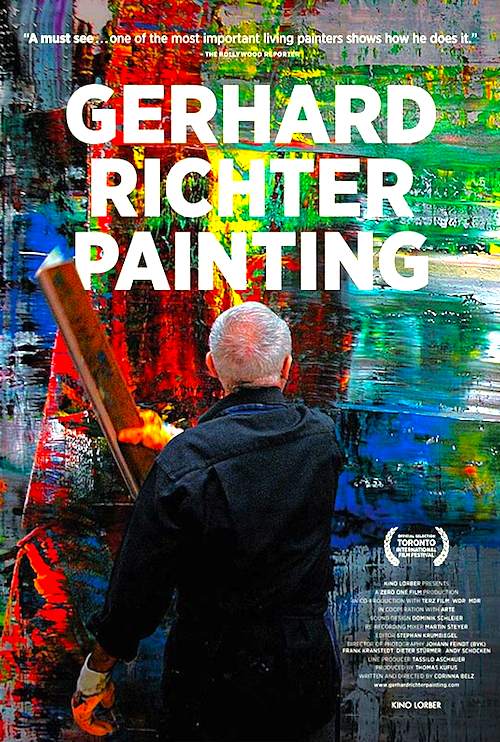By Joe Bendel. Perhaps no artist represents the force of creative destruction better than Gerhard Richter. Not surprisingly, such a Schumpeterian painter was ill-suited to the Social Realist doctrine dominant in the former DDR. Finding refuge in the West two months before the construction of the Berlin Wall, Gerhard’s work has reached dizzying prices at recent auctions. Filmmaker Corinna Belz documents the artist at work in Gerhard Richter Painting, now showing in New York at Film Forum.
For some, Richter’s work probably confirms their uncharitable preconceived notions about modern art. The Dresden-born artist is best known for his large abstract paintings and photo-realistic work that would seem to be stylistically at odds with each other. Throughout the film, Belz captures the increasingly self-conscious Richter at work on two canvases in the former style.
 After seeking asylum in West Germany in 1961, two Richter murals in the East were painted over out of dogmatic spite. Ironically, Richter deliberately subjects his work to similar treatment, roughly scraping his canvasses with paint squeegees to see how it alters their character. This process might continue past the point paintings are hung for exhibition. Indeed, there is something very Darwinistic about his approach, causing his assistants to openly speculate whether certain paintings will be able “to hold their own.”
After seeking asylum in West Germany in 1961, two Richter murals in the East were painted over out of dogmatic spite. Ironically, Richter deliberately subjects his work to similar treatment, roughly scraping his canvasses with paint squeegees to see how it alters their character. This process might continue past the point paintings are hung for exhibition. Indeed, there is something very Darwinistic about his approach, causing his assistants to openly speculate whether certain paintings will be able “to hold their own.”
GR Painting follows in the tradition of similar documentaries from Kino Lorber-Alive Minds, observing an artist or craftsman at work in their studio-space. However, the portrait of Richter is considerably more engaging than Gereon Wetzel’s El Bulli or Sophie Fiennes’s Over Your Cities Grass Will Grow, because Belz brings a more visually dynamic approach to bear on her subject, without the same hushed reverence. However, Richter and his colleagues do not offer the sort of witty commentary heard fly-on-the-wall style from photography book publisher Gerhard Steidl and his roster of artists in Wetzel & Adolphe’s shockingly entertaining How to Make a Book with Steidl.
While Belz touches briefly on Richter’s fateful flight west, her focus falls squarely on his creative process. Frankly, for those with more traditional aesthetic inclinations, each successive scraping often renders the two canvasses in question less interesting, blurring the color contrasts and breaking down the paintings’ implied compositional structure. That is just the reality of his working method. Many will find it fascinating, many others will not. At least Richter is a rather interesting figure to spend time with. Recommended for patrons well steeped in the contemporary art world, GR Painting screens through Tuesday the 27th at Film Forum in Manhattan’s eternally chic West Village.
Posted on March 16th, 2012 at 10:40am.